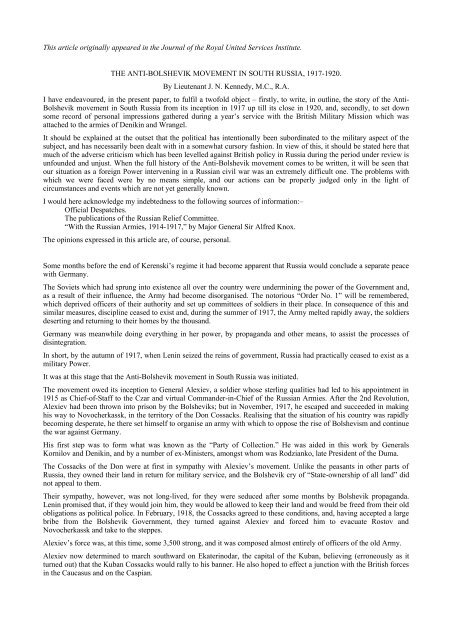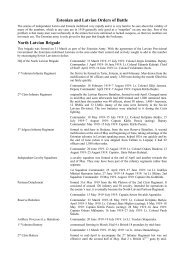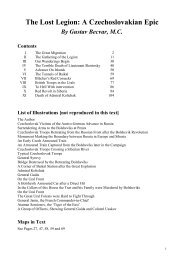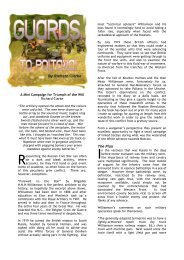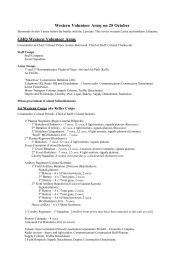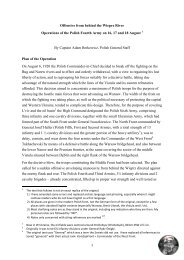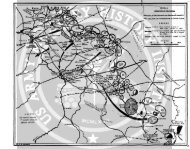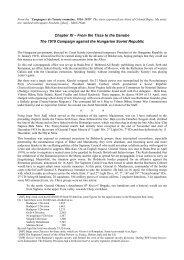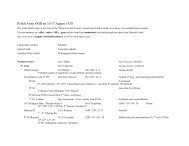Kennedy Article - Pygmy Wars Home
Kennedy Article - Pygmy Wars Home
Kennedy Article - Pygmy Wars Home
Create successful ePaper yourself
Turn your PDF publications into a flip-book with our unique Google optimized e-Paper software.
It has been said that the First Kuban campaign of the Volunteer Army, as Alexiev’s force had been christened, wouldcompare with anything in history for sheer gallantry.The Volunteers were insufficiently equipped and, for arms and ammunition, they had to depend entirely upon what theycould capture from the enemy. In spite of these disadvantages they fought their way, in the face of considerableopposition and in the dead of winter, from the Don to the Kuban River, a distance of some 200 miles. There were threeengagements of a desperate character, but the fighting was, for the most part, of a guerrilla type. Casualties on bothsides were severe and Alexiev’s men also suffered heavy losses from an outbreak of typhus.The Volunteers arrived before Ekaterinodar on 26th March, 1918, by which date their numbers had been reduced to700, and they proceeded to attack the town. The defenders, however, outnumbered them by three to one and werestrongly entrenched, so that they had no difficulty in beating off the assaults of the Volunteers.In one of these assaults General Kornilov, who had been acting as military Commander-in-Chief under Alexiev, waskilled by a stray shell, and General Denikin was appointed to succeed him in the command. The latter decided to giveup the attempt to capture the town and to extricate what remained of his force. He thereupon withdrew, with great skill,to the northward, and, taking his wounded with him, he reached Sredni Egorlak, on the border of the Don territory, bythe middle of April. Here reorganisation was undertaken.By this time the Germans, having forced the Treaty of Brest Litovsk upon the Bolsheviks and signed a separate peacewith the Ukraine, were in military occupation of the Crimea, the Ukraine, and the important industrial area of theDonetz basin.The Don Cossacks were now beginning to tire of Bolshevism. Perceiving this, the Germans came forward with an offerof assistance towards forming a separate Cossack State. This offer was accepted, and German arms and money were atonce poured into the Don.In pursuance of their policy of “Drang nach Osten” the Germans next attempted to come to terms with Alexiev, whoseforce was now the only obstacle to the opening up of a corridor to the East. Alexiev, however, refused to deal with themand held firmly to his watchwords of “No separate peace with Germany, no compromise with Bolshevism, a united andindivisible Russia.” Alexiev’s constancy to the Allied cause is the more to be admired in that Germany’s prestige was,for the moment, very high in Russia owing to her successful spring offensive in France and her recent defeat ofRumania.By the month of June, 1918, Alexiev had reorganised his force and, with 11,000 men, he once more took the field. Hedecided to make a second attempt to clear the Kuban of Bolsheviks and to establish a base on the Black Sea.The Second Kuban Campaign was a very different affair from the first, for it was almost in the nature of a triumphalprogress. A wave of reaction against Bolshevism had passed over the country and, not only the Kuban Cossacks, butlarge numbers of the regular Bolshevik forces as well, came over freely to join Alexiev.By November, 1918, the Volunteer Army had increased to some 50,000 men; enormous quantities of military stores hadfallen into their hands; and a base had been established on the Black Sea at Novorossisk.Alexiev died on 25th September, and so he did not see the fruits of his labours.General Denikin, who up till this time, had been military commander only, now succeeded to the leadership of themovement and was given supreme political power. Denikin had had a distinguished career in the Russian Army. He hadbeen a successful Corps Commander against the Germans and later he had served as Chief-of-Staff at G.H.Q.The collapse of Germany in November, 1918, naturally had a most inspiriting effect upon Denikin’s Army.The Dardanelles having been thrown open, the Allies were at last able to get into touch with him, and a British MilitaryMission arrived at his Headquarters in the Kuban in December. On receiving the report of this Mission, the BritishGovernment undertook to send out arms and equipment sufficient for 250,000 men and the French also promised help.Under pressure from the British Military Mission the Don Cossacks now relinquished their separatist ideas andacknowledged Denikin as Commander-in-Chief of all the Anti-Bolshevik forces in South Russia – which was a greatstep forward. The forces under Denikin’s command were thereupon re-christened the “Armed Forces of South Russia.”Supplies began to arrive in the spring of 1919 and the work of re-arming Denikin’s troops was begun.The effect of British assistance, both moral and material, was magical. The Bolsheviks were driven back everywhere,and Denikin’s Army swept forward through the Donetz basin and into the Ukraine.By the middle of June Denikin’s forces had been organised in four armies, comprising in all some 200,000 men. Thesewere disposed as follows:–The Terek and Daghestan Army (General Erdeli) advancing to strike the Volga north of Astrakhan, theCaucasian Army (General Wrangel) advancing on Tsaritsin, the Don Army (General Sidorin) advancing onVoronejh, and the Volunteer Army (General Mai-Maievski) directed upon Kharkov.
The line at this time is shown on Map “A”.Denikin now attempted to push forward his right wing to the line Saratov–Tambov–Voronejh, pivoting on the RiverDnieper, and he hoped to join hands with Kolchak, who was advancing from Siberia. His hopes, however, were neverrealised.By the late summer of 1919 the Armies were extended on a front over 1,000 miles long, and a policy of consolidationwas recommended to Denikin by his advisers. He did not feel secure enough, however, to adopt this course. There wasmuch discontent amongst the civilian population behind the Army, owing to the fact that the commercial life of thecountry had not been re-established, and many adverse political influences were also at work. Having this situation inview, Denikin felt that it was only by continuing the offensive that his army would hang together. In this appreciation ofthe case he was justified by the previous experience of Admiral Kolchak, whose attempt to halt long enough to trainfresh levies before continuing his advance in Siberia had ended so disastrously.At this period I paid a visit to the front of the Volunteer Army, and some account of my experiences may be of interest.I had been assigned for duty to the 1st Corps of the Volunteer Army, which was operating at this time in the vicinity ofKursk.On my way up to the front I spent a few days with the Corps Headquarters at Kharkov, where I made the acquaintanceof General Kutiepov (the Corps Commander) and his staff. The Headquarters Staff struck me as being very much out oftouch with the troops at the front. They were, in fact, over l00 miles behind the line at this time, and from such adistance it must have been impossible to co-ordinate the action of their command. Visits to the fighting troops seemedto be almost unheard of.Whilst at Kharkov I was invited to accompany the Inspector-General of Artillery on a formal inspection of a batterywhich had just been armed with British 6-inch howitzers. The Inspector General was attended on this occasion by hisadjutant and a bodyguard of half-a-score of wild-looking Cossacks armed with lances. When the usual salutations hadbeen exchanged, the battery wheeled into column and cantered past the saluting base with much flourishing of swordsand shouting. The gun teams consisted each of ten wretched little Cossack ponies and it was amazing to see them movethe heavy howitzers at such a pace. We next saw some drill which was remarkably smart. The General then ordered hisbodyguard to make a sham cavalry charge upon the battery and, as the Cossacks galloped down upon it, the guns wereunlimbered and brought into action very creditably.After the inspection we partook of a barbaric meal with the battery officers, at the conclusion of which we were all, theGeneral included, tossed in the air several times in accordance with the Russian custom. This, by the way, cannot berecommended as an aid to digestion!On 26th September I set off for Kursk, which had been captured some days before.During the journey to Kursk, as on my previous journey to Kharkov, I remarked an extraordinary congestion ofpassenger traffic on the railways. Not only was every railway carriage and truck crowded almost to the point ofsuffocation, but passengers also travelled on the roofs and footboards of the trains. At the larger railway stations it wasonly with considerable difficulty that one could make one’s way through the waiting rooms and across the platforms,for these were crowded with hundreds of peasants who were camping out there whilst awaiting the arrival of trains.These peasants were travelling between the country districts and the towns in order to sell flour, which they carried withthem in sacks. As may well be imagined, this primitive method of trading entailed a very uneconomical use of rollingstock, and reacted seriously upon the system of military transportation. The reason for the retail traffic in flour was thatthe local governments in South Russia would not approve of the movement of grain in bulk outside their ownboundaries, partly because supplies were nowhere abundant and partly because prices were too unstable for regulartrade. This state of affairs was one of many indications that Denikin’s administrative measures were inadequate.I spent some days at Kursk in order to visit units in the vicinity.Here I heard some details of General Mamontov’s famous Cavalry raid of the preceding August. Mamontov (who, bythe way, was said to have been a keen hunting man before the war and master of a pack of hounds at Moscow) brokethrough the Bolshevik front at Makarovo with a Cavalry Corps of Don Cossacks and penetrated many miles into enemycountry to Tambov, which was the main supply depot of the Bolshevik Southern front. He captured 10,000 prisoners,disarmed double that number of Bolshevik conscripts, and recruited two infantry divisions which he added to his force.Being hard pressed on one occasion he buried his guns and converted the drivers into cavalrymen. These guns weresubsequently dug up again when the Army advanced. Altogether Mamontov was behind the enemy’s lines for about amonth; but this operation, which might have achieved considerable results, degenerated into a looting expedition.Mamontov failed to carry out his mission, which was to destroy the enemy’s communications, and in particular those ofthe 8th Bolshevik Army. This Army, owing to Mamontov’s disobedience, was able to make an advance on Kupianskwhich seriously hampered Denikin’s offensive. The conduct of the Cossacks on this occasion had a considerableinfluence in alienating the people from Denikin’s cause.At Kursk I met General Shkourov, a young cavalry leader who had achieved considerable distinction by his recklessdaring in the earlier stages of the campaign. In appearance he was like a shaggy little peasant. His conversation wassomewhat amusing – he spoke, for instance, of “building up a new Russia on the stinking corpses of the Bolsheviks”; healso remarked that he had heard there were some Communists in England and that he would like to come here after the
war was finished and show us how his Cossacks could deal with them. As a Cavalry Corps Commander he degeneratedrapidly and fell into dissolute habits. He encouraged looting in order to retain his popularity – with the usual results.Finally he was dismissed from his command and disappeared into obscurity.I left Kursk on 9th October and, having travelled by motor-car a distance of some 60 miles along the Moscow road, Iarrived late at night at the little village of Kozlovka.It was by the merest chance that I discovered this village to be almost in the front line, for, as we were passing throughit in the moonlight, I caught sight of some guns in an orchard and, on enquiry, I found that I was in the most advancedpositions of the 2nd Kornilov Regiment. But for this we might have driven unchallenged into the enemy’s lines, for Ihad been unable, before leaving Kursk, to get exact information as to the position of the troops.I was given quarters in a cottage and turned in at once on learning that the advance was to be resumed at an early hournext day. An artillery Colonel billeted in my cottage insisted upon my taking the only available bed, whilst he sleptupon straw scattered on the floor.On going out just before dawn next morning I observed that most of the men had been sleeping on the ground all nightwithout any covering beyond their great coats, although the temperature was at this time several degrees below freezingpoint. They were now bestirring themselves and crowding round great bonfires to warm their stiffened limbs.By 5.30 a.m. the light was sufficiently good for observation, and I rode up to the crest of a neighbouring ridge in orderto see the enemy’s position. This consisted of a line of rifle pits dug along the further side of the valley and at rightangles to the road. The country was open, rolling steppe-land, a very small portion of which was cultivated, and therewas little or no cover anywhere. It was ideal country for military operations, being everywhere passable to all arms.Our artillery had already opened fire, five batteries being engaged, viz. one 6-inch howitzer and two 60-pr batteries,sited in the vicinity of Kozlovka, and two 18-pr batteries in position further out on the flanks. The bombardment wascontinued at a slow rate for some two hours without any enemy movement being observed, At about 8 a.m., however, ascore or so of the enemy’s infantry bolted from their pits into the open and several of them were shot down by ourmachine guns which were posted on the slope below.The enemy’s artillery now made some reply and a howitzer of 6-inch calibre or thereabouts began to drop shells at aslow rate on the road near us. A battery of field guns was also active, searching and sweeping around the village.At 9 a.m. a body of enemy cavalry, about 150 strong, appeared on the ridge in front of Dobrynye, about a thousandyards off, and galloped towards us extended in two long lines. Behind them followed a droshky. On enquiry I was toldthat a droshky was the usual means of locomotion of the Commanding Officer on such occasions. Our 6-inch howitzerbattery opened fire and the first round fell just short of them. After a few more well-directed rounds had been fired, theBolshevik Cavalry changed direction, rode off to the left and disappeared again behind the ridge, the droshky followingat full gallop.It appeared evident by 10 a.m. that we were faced by a small rearguard only and that the enemy’s main body hadwithdrawn. An advance was, therefore, ordered and our little column was soon on the move.First a small advanced guard moved ahead consisting of two armoured cars and a troop of 30 cavalry scouts.A mile or so behind the advanced guard came the main body, the order of march being as follows – three “officercompanies” of the 2nd Kornilov Regt (These companies were entirely composed of officers of the Old Army and wereamongst Denikin’s best fighting troops. – J.N.K.), the 60-pr and 6-inch batteries, and then the transport, which consistedof several hundreds of country carts loaded with sheep and geese and driven by peasants. These country carts, I learned,were requisitioned in the villages and usually accompanied the troops for two or three days’ march, after which theywere replaced by others and sent home again. They were preferred by the Russians to limbered wagons for transport ofartillery ammunition, for they were more mobile. The ordinary peasant’s cart drawn by one horse will take 12 completerounds of 60-pr or 30 rounds of 18-pr ammunition.Behind the transport there followed a small rearguard of infantry.About 2 miles out on either flank were flank guards consisting each of two companies of Infantry and one 18-pr battery.The fighting strength of the column was about 2,000.Between our column and the nearest troops operating on either flank there was an interval of about 20 miles.After we had proceeded about 1 mile our advanced guard was checked by the enemy rearguard, which was holding atrench on the crest of a hill which commanded the road. The leading company of infantry deployed and rushed it andthe occupants of the trench were bayoneted. Their bodies were quickly stripped of clothing, of which our men were inneed, and they were then left lying naked on the ground.We now got a view of the Bolshevik force streaming away across country about three miles off. It seemed to be ofabout equal strength to our own, but, unfortunately, we were too weak in cavalry to take advantage of the situation.Their retreat was being covered by a 3-inch battery which had come into action against us in the open. A few roundsfrom one of our 6-inch howitzers caused it to limber up and gallop off.
At 5 p.m. the little town of Kromi was occupied and here some 200 prisoners were taken. These prisoners, who weremostly of the peasant class, were immediately sent as reinforcements to the batteries. I gathered that they wereindifferent for the most part as to the side for which they fought. During the evening outposts were pushed out sometwo miles to the north of Kromi and the bulk of our force was billeted in the town.As the only bridge across the River Kroma had been demolished, the artillery was parked in the little village ofZakromskoie on the southern bank.Food supplies in the town were found to be scanty, bread being very scarce and such common articles as salt beingpractically unknown. There were numbers of geese, however, and these formed the staple food of the troops.The inhabitants of Kromi and Zakromskoie received us well and manifested great delight at the departure of theBolsheviks. The questions put to us by the peasants indicated an intense interest in Denikin’s agrarian aims; but thesequestions, I noticed, could not be answered very satisfactorily, for Denikin had not promulgated a definite land policy.This lack of policy was a grave error, for the idea naturally gained ground that he intended to restore their properties tothe former landlords and to reduce the peasants once more to a state of serfdom. The consequent hostility of thepeasants was a considerable factor in Denikin’s downfall. There was a very evident need for propaganda amongst thepeasant class as a counter to that of the Bolsheviks, but, although this need was repeatedly pointed out by Britishofficers, no effective steps were ever taken to meet it. The absence of a due expression of the case for Denikin wasmuch felt.Evening reports showed that our total casualties in killed and wounded amounted to 50. These casualties had beenincurred for the most part in street fighting in Kromi.The peasants worked all night to build a timber bridge across the river and early next morning (11th October) the gunswere able to cross. This work of bridge construction was always very efficiently and quickly done by the peasants underthe direction of the village carpenters. The bridges were of the ordinary crib-pier type.No advance was made on the 11th as the division on our left had not come up sufficiently to protect our flank. In theevening, however, we heard their guns and learned that they were pushing forward, although stiff opposition was beingencountered.On the 12th we resumed the advance, but we did not establish touch with the enemy until the evening, when we cameup with him near the village of Kotovka. He had taken up a position here along a wooded crest. There was an exchangeof artillery fire, but nothing further occurred before darkness fell.On the 13th the Bolsheviks again fell back and we pressed close on their heels. On reaching Yakovka we found thebridge across the river in flames. The peasants were still actually engaged in bringing up straw to keep it alight, as theyhad been ordered to do; but, on seeing us, they hastened to bring water to extinguish the fire.The infantry were thrown across by a footbridge and in the course of a few hours the peasants had made a bridge to takethe guns.A mile or so north of this village we obtained our first view of the town of Orel (Orel has a population of some 80,000inhabitants. – J.N.K), which was our objective. The River Tzon, which flows round the southern outskirts of the town,was strongly held by the enemy and a sharp action was already in progress when I arrived.The enemy’s position was a strong one and had evidently been prepared with care, for it was entrenched and well wired.It was sited along a wooded ridge on the further bank of the river.When I arrived the Commander of the 2nd Kornilov Regt was driving about in an old droshky, amongst his mostadvanced troops. A map was spread upon his knees and he seemed to be quite oblivious of the shells which fell aroundhim and of the machine gun bullets which whistled over his head.A reconnaissance revealed what appeared to be a considerable gap in the enemy’s wire entanglement at a point some2,000 yards west of the main road and it was decided to attack here. Four companies of infantry, selected for the assault,were moved to the cover of a wood opposite the gap. Our field batteries presently opened fire on the enemy’s position,the 60-prs being employed on more distant targets, such as the railway station in the town itself. The 6-inch howitzerbattery was moved up to support the main attack. I remarked that only one large scale map was available on thisoccasion and this had to be passed round to the infantry and artillery officers, who made sketches from it for their ownuse.Whilst these preparations were still in progress a Cossack galloped up with a message from the 1st Kornilov Regt,which had been advancing along the railway on our right. This message requested us to stop our 60-pr guns firing, asthe 1st Kornilov Regt was making an encircling movement round the north of the town and hoped to enter from thatside. Half an hour later this movement began to take effect and the enemy was seen to be evacuating his position alongthe river bank. But they were too late, for the 1st Kornilovs were already in their rear. Three thousand prisoners werecaptured, and four 3-inch guns were also taken. As regards the prisoners taken in Orel, the men were disarmed,deprived of their great coats and set free; the officers, I was told by the Commander of the 1st Kornilov Regt, would beshot, but I had no opportunity of verifying this.
Fighting continued in the suburbs of the town all night, but by 9 a.m. on the 14th Orel had been completely cleared ofthe enemy.The capture of Orel had remarkable effect upon the morale of the Kornilov Brigade and indeed upon that of the wholeof the Volunteer Army. Orel was regarded as one of the bastions of Moscow (it had been founded in the 16th century byIvan the Terrible for the defence of the Grand Duchy against the Tartars), and now it seemed only a matter of daysbefore Denikin’s troops would march into the Bolshevik capital.I was much struck by the cowed and broken appearance of the inhabitants of Orel, who had evidently suffered muchduring the Bolshevik regime,A number of Jews and others, who were denounced as Bolshevik commissars, were summarily shot in the streets. Theirbodies were left to lie on the pavements for days and were gradually stripped of clothing by the passers-by.A certain amount of pillaging took place, but this was not general, and the behaviour of the Volunteer troops was goodon the whole.It was decided not to continue the advance next day as the Kornilov Brigade was now in a dangerously advancedposition owing to the troops on either flank having been held up. A strong line of outposts was therefore, pushed out allround the town.On the 14th October I attended a review of the Kornilov Brigade, which was held in the town square. The troops onparade were the 1st and 2nd Kornilov Regts (the 3rd Regt being on outpost duty), and four batteries of field artillery.Col. Skobelin, the brigade commander, had already arrived and was galloping up and down the line on a spirited horseshouting greetings to the men and receiving a chorus of deep-voiced answers. These preliminaries concluded, headdressed them and congratulated them upon the capture of Orel. A procession of robed priests now filed out of theCathedral bearing banners and standards, and the chief priest proceeded to read a prayer for the continued success ofDenikin’s arms. (For this, I may remark in passing, he was executed by the Bolsheviks when they recaptured the town afew days later.) He then proceeded to pronounce a benediction, sprinkling holy water over the bared heads of theofficers as they crowded round. A march past concluded the proceedings.In Orel there was a certain building which had been used by the Bolshevik “Cheresvecheka” as a prison and torturehouse. In the courtyard of this building we found the bodies of fifteen well-known civilians, who had been carried off ashostages by the Bolsheviks from Kharkov and other towns in South Russia. These unfortunate people had been shot justbefore our arrival in the town. Amongst them was Professor Besegen of Kharkov University, whose son wasaccompanying me as interpreter. In the prison were fifteen more hostages still alive – amongst them two ladies. Theywere in a pitiable state of prostration as a result of the privations they had suffered. These survivors told us that theyowed their lives only to the timely advent of the Volunteer troops, for orders had been given to shoot them all.I was dining with the officers of the Brigade Headquarters on the evening of the 14th when a mud-stained horsemanarrived with somewhat alarming news. He was a gun-team driver of a section of 18-prs which had been delayed forsome reason the day before and had been left to follow a few miles in the rear of the column. His news was that a forceof Bolshevik cavalry, estimated at 2,000 sabres, had swept round our left flank, and had occupied Kromi, thus placingthemselves astride our line of retreat. The two 18-prs had been captured and he alone had escaped. In consequence ofthis information the 2nd Kornilov Regt, with a battery of 6-inch howitzers, was given orders to march on Kromi atdawn the following morning with the object of re-opening communications. On the next day this Regiment marched toKromi without encountering the enemy. The town was found to be unoccupied and the hostile cavalry was reported tohave moved off in an easterly direction in the morning. Later it was ascertained that the manoeuvre had been in thenature of a raid only and that the Bolshevik cavalry had ridden right round us and back into their own lines.This completes an account of my visit to the Orel front, for I left on the evening of the 16th for Kursk.With the capture of Orel the high-water mark of Denikin’s advance had been reached. Bolshevik resistance now beganto stiffen and he was held up all along the line.There now followed a very critical time for the Anti-Bolshevik forces. The discontent of the civilian population wasaugmented by the continued weakness of Denikin’s administration and by the failure of his efforts to enlist foreignassistance in the economic reconstruction of the country. Denikin at this time had little real authority over the variouslocal governments in South Russia, and these governments were hopelessly corrupt and inefficient. Conditions of lifeunder them were little better than they had been under the Bolshevists.Many armed risings took place in his rear, one of the most dangerous of which was that headed by a peasant calledMakhno, who attracted a very large following of malcontents and became a serious menace to the lines ofcommunication. His cries of “Land for the peasants, no compensation for the owners, abolition of all authority;” and“Down with the Jews” were very popular amongst a certain class. In the Ukraine, Petliura continued to foster hostilityto Denikin, and agents of the Soviet Government were active everywhere in spreading seditious propaganda. Discontenthad spread to the Army and signs of disaffection were apparent. The ranks had been filled with conscripted peasantswho were unwilling to fight and with large numbers of prisoners captured from the Bolshevists. The Cossacks, who hadnever fought with much enthusiasm outside their own borders, were getting tired of the war and they deserted in large
Had Denikin’s economic position been sound, his military operations could hardly have failed, in view of thesuperiority which the backing of the Allies had given him. His failure is yet another example of the fact that an Armymust depend for its very existence upon a sound civil administration. It would have been a miracle had he achieved alasting success, having regard to the chaotic state of affairs in that portion of Russia which was governed by him.Whether he could have long maintained his position had he defeated the Red Armies and entered Moscow is open toconsiderable doubt.Denikin himself was a great and single-minded patriot, but his gallant and devoted efforts were brought to nought bythe corruption and inefficiency of a large proportion of his entourage. His council and his staff included many Russianswho could not realise that the old regime had passed away for ever and who did everything in their power to obstruct allefforts at democratic reform.Baron Peter Wrangel, who now became Commander-in-Chief of the A.F.S.R., was not a professional soldier. Duringthe war against Germany, however, he had gained great distinction as a cavalry leader, and later, under Denikin, he hadshown high qualities of generalship. He was by far the most capable of Denikin’s Army Commanders, and he possessedthe full confidence of the troops.He now proceeded to reorganise what remained of the army in the Crimea, and he accomplished wonders in a veryshort time.Repeated attacks were made by the Bolsheviks on the Isthmus of Perekop, but these were beaten off. It was not such asimple matter to defend this Isthmus as might appear from a study of the map. A great part of the Sea of Azov is stillfrozen at this period of the year and, on the western side, the Gulf of Perekop is so shallow as to be easily fordable inmany places.At this juncture the Allies attempted to mediate between Wrangel and the Bolsheviks with a view to getting the Crimearecognised as a separate State, but the negotiations came to nothing.In April Wrangel undertook an advance into the cornlands of South Russia in order to secure supplies, for the resourcesof the Crimea had been exhausted by the needs of the Army and of the enormous numbers of refugees who swelled thepopulation.In the opening stages of the operations which now took place I paid a second visit to the front, of which a short accountfollows.That part of the advance which I witnessed was in the island of Chongar, by which the railway crosses from the Crimeato the mainland. An interesting feature of the fighting was the use of armoured trains. As a result of what a saw I feelconvinced that armoured trains have considerable potentialities in irregular warfare against an ill-armed enemy and thatthe method of their employment would, therefore, seem to merit some attention.The force operating in Chongar Island consisted of some 500 infantry, three batteries of field artillery and two armouredtrains, one of which was armed with two 18-pr guns and the other with a 60-pr. The trains were made up as follows:first a truck, upon which spare sections of railway line were carried, next the armoured gun trucks, and, behind these,the engine, also armoured.The Bolshevik force was estimated at 800, but it was weaker in artillery and their armoured trains, of which they alsohad two, were armed with 3-inch guns only.There was little or no fighting by the infantry, who advanced, as a rule, in line formation astride the railway in rear ofthe armoured trains. It was chiefly an affair of duels between the trains. Our armoured trains moved slowly ahead,keeping up a rapid fire on the Bolshevik trains, and engaging the enemy’s infantry and field batteries whenever afavourable target presented itself. At times the trains on both sides were hit, but I never saw one derailed or severelydamaged.I was interested to observe the great moral effect exerted by the trains. It was evidently felt that field artillery washelpless against them. The country was flat and there was practically no cover of any description, so that whenever abattery came into action it formed a good target for the trains and was soon neutralised. It never seemed to strike theRussian gunners that the best way for a battery to attack an armoured train is to scatter the guns over a wide front anddirect a converging fire upon it. The guns of the trains will then have more targets than they can deal withsimultaneously and those targets will be small.At one place a trench was held by the enemy on a low ridge which crossed the line of the railway at right angles. Ourleading armoured train steamed up and opened enfilade fire along it at point blank range, with the result that a numberof the enemy’s infantry were killed or wounded and the remainder took to flight.Just after this trench had been taken a rather amusing incident occurred. A halt had been ordered and the troops had laindown to rest, and several of us British officers (who were there merely as spectators) had walked out a short distancebeyond the most advanced line of infantry in order to get a better view from some high ground in front. There seemed to
e no danger, for we could see the enemy’s column moving away in the distance and no shooting was taking place. Wewere, therefore, somewhat startled when all at once a machine gun opened fire upon us at close quarters. A Bolshevikarmoured train had suddenly appeared from behind the buildings at the little railway station of Chongar near by, whereit had been lying hidden, and was now steaming rapidly towards us. The eyes of all were upon us, and we felt we couldnot run, although we should have liked to do so, for the machine gun bullets were whistling unpleasantly close over ourheads and there was no cover at hand. We, therefore, began to walk back in as dignified a manner as possible. At thismoment, fortunately for us, our own armoured train sallied forth to our assistance and proceeded to shell the enemytrain and drive it back, Before this encounter I had had rather a contempt for armoured trains, but I must now confess toa certain amount of respect for them!By 18th April a bridgehead had been gained on the mainland round Salkovo, and here a line of trenches was dug whichwas to be held until the railway could be repaired.On the 19th we walked round the front. From the men in the trenches we learned that during the preceding forty-eighthours they had had one hot meal only and, beyond this, they had had no food except raw salt herrings. In spite of thismiserable treatment, which was entirely due to the inefficiency of the administrative staff, these men fought well thatnight and beat off a heavy counter-attack. The powers of endurance of the Russian soldier are truly marvellous.During the operations we more than once saw General Slashchev, the Corps Commander. Slashchev was extremelypopular with the troops owing to his great personal courage, but, unfortunately, his habits, like those of so manyRussian officers, were dissolute, and he was addicted to drink. He was invariably accompanied on his visits to the frontby one of his “lady orderlies” in male costume.The British Mission was withdrawn from the Crimea at the end of June, 1920. Its functions had been to train and toadvise, to inspect units armed with British equipment at the front, to keep the War Office informed of Denikin’srequirements, and, latterly, to supervise the supply of all stores and equipment to the fighting troops.After our departure Wrangel made a considerable advance into South Russia, but in November the Bolsheviksconcentrated against him and overran the Crimea.The remnants of his Army were evacuated from Sebastopol to Constantinople, and so ended the Anti-Bolshevikmovement in South Russia.The main characteristic of the operations was their extraordinary mobility. The plains of South Russia favour freemovement of troops everywhere, although there are but few metalled roads. Owing to the difficulties of supply,however, the main operations were confined as a rule to the vicinity of the railways.The tactics employed have a certain interest when the operations are considered in the light of irregular warfare againstan ill-armed enemy such as may recur in the small wars of the future.It is a curious fact that, although the Russians have always been particularly strong in cavalry, and although the natureof their country favours mounted action, yet they have never mastered the principles of the employment of this arm.During the Great War it will be remembered that there were constant instances of the misuse of cavalry by the Russiancommanders, perhaps the most striking example of this occurring in Galicia in 1916, when the Russian cavalry wereoffered and failed to seize an opportunity, such as comes but seldom in war, of decisive action against the demoralisedand broken Austrian army.The operations in South Russia were but a repetition of history so far as the cavalry was concerned. Cavalry, properlyhandled, would have been of the utmost value in cutting communications, for instance; but Denikin’s cavalry was notproperly handled and its power was largely wasted in raids which had no bearing on the main operations.Golden opportunities for minor cavalry actions constantly occurred, but cavalry were seldom available to takeadvantage of them. This was chiefly due to the fact that infantry divisions were assigned an inadequate proportion ofcavalry – insufficient even for scouting purposes. It would seem that for a campaign in a country such as Russia thereshould be, in addition to large cavalry formations, a greater proportion of cavalry in the division of all arms and in thearmy corps.Russian cavalry tactics are antiquated. For instance, they never, to my knowledge at least, fought dismounted, althoughthe necessity for dismounted action might well have been impressed upon the Russians in the late war, if not by theirprevious experience in the Russo-Japanese War. There is no doubt that the Cossack despises dismounted action, and hisvalue as a cavalryman is thus considerably decreased. The Cossacks, too, are robbers by instinct, and it seems unlikelythat they could ever be trained up to the standard of first-class European cavalry. They are undoubtedly good horsemenand fine swordsmen and they have great powers of endurance, but they are easily depressed, and unreliable when thingsare not going well.The Tartars, of whom a considerable number were fighting for Denikin, have perhaps greater potentialities ascavalrymen. They are just as hardy, they are good fighting men, and they are more amenable to discipline.
A number of Mongols were also serving with Denikin’s cavalry. They are especially hardy, and are said to be able tosubsist entirely upon mares’ milk, which is more nutritious than cows’. They are, therefore, independent of supplies andcan move through uninhabited country with freedom.As regards the Kirghiz, I understand from officers with a knowledge of India that they would probably equal our finestnative mounted troops if led by white officers.The artillery of the A.F.S.R. comprised an extraordinary variety of armament, of German, British and Russianmanufacture. Of the field guns the Russian 3-inch gun proved the most satisfactory weapon, and it withstood the wearand tear of the campaign better than the British 18-pr, which was constantly going out of action owing to the roughhandling which it received. The carelessness with which the Russians handled their equipment was striking. Triflingdefects were constantly disregarded and guns were kept in action until serious damage had developed. There was anenormous demand for buffer springs, the reason for this being that the batteries were frequently in action at extremeranges. The normal reserve supply of springs proved to be quite inadequate. In a country like Russia, where targetsconstantly present themselves at long ranges, a gun with a longer range than the old type of 18-pr, is clearly desirable.Horse-drawn medium artillery was generally able to keep pace with other arms in operations, but the 6-inch howitzerproved to be greatly superior in mobility to the 60-pr owing to its smaller weight. Medium guns and howitzers, whendrawn by tractors, were found not to be sufficiently mobile. They were always held up at river crossings until heavybridges could be constructed, with the result that they were seldom up in time to take part in the fighting. In retreattractor-drawn guns were generally abandoned, even when there were no obstacles to movement, owing to their slowpace.As regards horses, it may be noted that there is some difficulty in Russia in obtaining animals of a sufficiently heavytype for artillery. The ordinary Russian horses are small and the harness and shoes used in our Service were found to bemuch too large for them.I was impressed by the advantages offered by the Russian system of grouping batteries in “divisions”, which consisted,as a rule, of two batteries each. A number of “divisions” composed a brigade. For close co-operation with infantry inrapid movement this seems an ideal arrangement, and it would appear to lend itself equally well to co-ordinated artilleryaction in deliberate operations. [Note: here he is translating the Russian divizion as “division” where “battalion” wouldbe better; the Russian for “division” is diviziya.]An interesting point which arose was the unsuitability for use in Russia of the buffer oil employed in the British service.This oil is liable to thicken and freeze in the winter to such an extent as to be quite useless.The infantry tactics employed in these operations were behind the times. The Russians seem to have stood still in thelast war, while the Allies were developing new tactical methods, and they seem to have learnt little or nothing fromtheir experiences on the German front.Attacks were generally carried out in line formation with little or no depth, and in defence it was also evident that themodern idea of depth was not realised. At the same time it will be generally admitted that the depth of infantrydispositions may be considerably modified in less highly organised forms of warfare.In attack infantry were often moved forward against the enemy in horse-drawn carts, under cover of artillery fire.The quality of the infantry regiments in Denikin’s army varied enormously. Some were composed of peasants who hadbeen mobilised against their will and who were unintelligent and untrained in war. They were naturally poor. Others,such as the Kornilov Regt, consisted largely of officers of the old army who fought in the ranks, and these were as fineas any infantry in the world.As regards machine guns, it may be noted that, in order to make them sufficiently mobile to keep up with fast-movinginfantry and cavalry they were often lashed on light carts drawn each by four horses, and they were fired from thisposition. This expedient achieved its object.The country is peculiarly suited to the unrestricted movement of tanks, for, with the exception of the rivers, there are noobstacles to movement south of the forest belt.The tanks supplied to the A.F.S.R. were of the older patterns. Their moral effect was so great as to be almost magical,but lighter tanks, such as the “Whippet”, would have been of greater value.It is probable, however, that an enemy more accustomed to these weapons than the Bolshevik of that period would havebeen able to make an effective resistance to tanks by resolute handling of his artillery, because the complete absence ofnatural cover places the former at a considerable disadvantage.Armoured cars were of great value and could have been effectively employed in far greater numbers. Armoured carsand cavalry were found to be an ideal combination which proved as efficacious as it did in somewhat similarcircumstances during General Ironside’s recent operations in Persia.As has already been stated, experience in South Russia would seem to indicate that armoured trains have a considerablevalue in irregular warfare. Denikin also used them to some extent for the protection of his lines of communication, andit seems probable that for operations in a hostile country this should be a normal rôle.
The Air Force of the A.F.S.R. was perforce inadequate, and such work as was carried out was done, for the most part,by British personnel.The aeroplane has undoubtedly tremendous potentialities as a weapon of offence on the open steppes and there werenumerous instances of effective low-flying action against troops on the ground, the most interesting occurring, perhaps,during the defence of Tsaritsin in the autumn of 1919, when repeated cavalry attacks were driven off by aeroplanes.Aeroplanes and cavalry might have co-operated more closely. In this connection the failure to keep touch duringMamontov’s raid may be quoted. On this occasion touch was eventually regained with Mamontov at Voronejh bymeans of De Havilands, but his whereabouts had been unknown for some weeks before.The shortcomings of the staff were attributable not only to the poor quality of the average Russian Staff Officer, butalso, in great measure, to the fact that the command was very much out of touch with the fighting troops. Headquarterswere, as a rule, too far from the front – for instance, Corps Headquarters were sometimes 140 miles and DivisionalHeadquarters 80 miles behind the line.I was constantly impressed by the good fighting qualities and powers of endurance of the Russian soldier even at thistime when the national morale was at a low ebb.It is of interest to note that Lord Wolseley, writing of his service in the Crimean War, referred to the Russians as “aboutthe finest infantry in the world – in fact fully as brave as our own”; and, again, as “the most stubborn of fighting men”.General Sir Alfred Knox, in his recently published book, “With the Russian Army, 1914-1917”, makes some instructiveobservations on the Russian people as a fighting race. He points out that, although Russian peasants lack individualityand natural initiative owing to centuries of serfdom and low mental development, no attempts were made in the prerevolutionarmy to remedy these defects and to raise their morale by instilling into their minds a thinking patriotism. Heemphasises the fact that the men are splendid material and that, owing to the rigour of the climate and his lowerstandard of civilisation, the Russian soldier is well fitted to stand privation and, with proper training, should beexceptionally capable of standing the nerve-strain of war.One of the weakest points in the post-revolution armies, as in the Old Russian army (although it was not fully realisedbefore the war) was the officer element. The majority of the Russian officers proved themselves to be corrupt andinefficient. They lacked a sense of duty and they took no interest in the welfare of their men. Their attitude isilluminated by the following reference to one of his men made by an officer in my hearing: “He is a peasant – he isnothing!” Another advised me to treat my Cossack servant “like a dog” in order to get good work out of him.Not until Russia can produce a good officer class or can call in officers of the right stamp from a foreign nation, willshe, in my opinion, become a great military power. No soldier responds more readily than the Russian to good treatmentand good leading. Led by good officers the Russians would be accounted amongst the best troops in the world.


